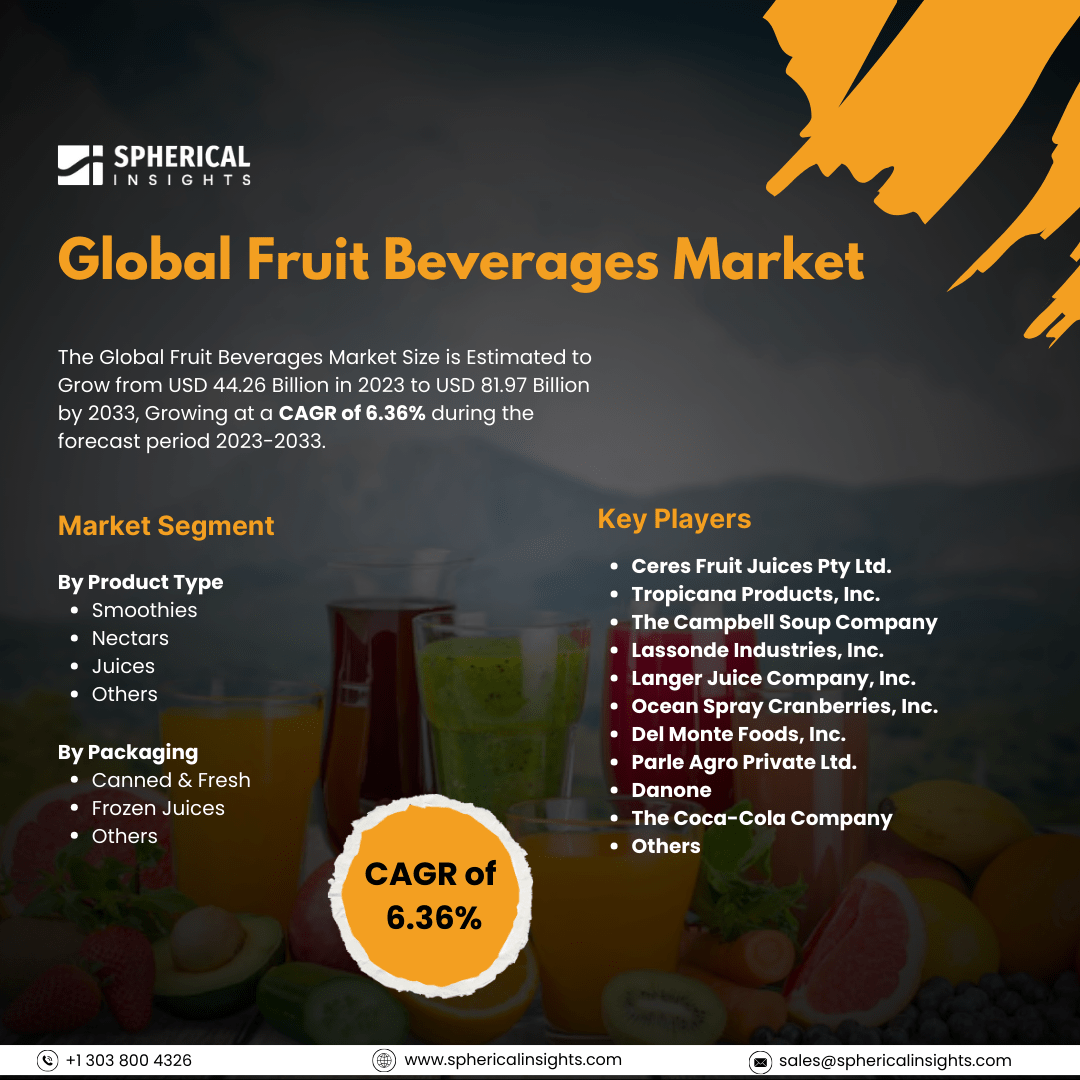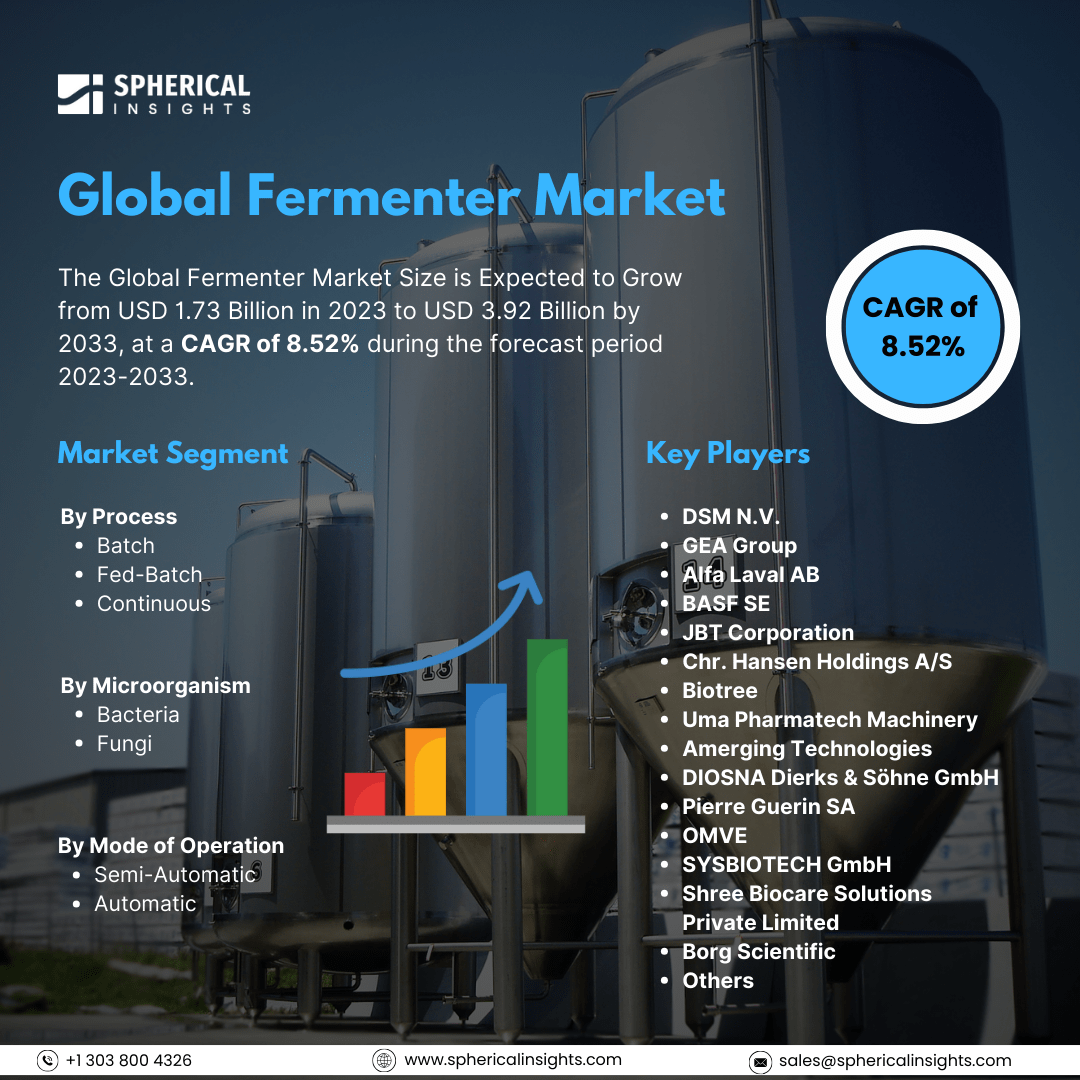Global Fruit Beverages Market Size to Worth USD 81.97 Billion by 2033
According to a research report published by Spherical Insights & Consulting, The Global Fruit Beverages Market Size is Estimated to Grow from USD 44.26 Billion in 2023 to USD 81.97 Billion by 2033, Growing at a CAGR of 6.36% during the forecast period 2023-2033.
Browse key industry insights spread across 215 pages with 110 Market data tables and figures & charts from the report on the Global Fruit Beverages Market Size, Share, and COVID-19 Impact Analysis, By Product Type (Smoothies, Nectars, Juices, and Others), By Packaging (Canned & Fresh, Frozen Juices, and Others), By Distribution Channel (Supermarkets/Hypermarkets, Convenience Stores, Online, and Others), and By Region (North America, Europe, Asia-Pacific, Latin America, Middle East, and Africa), Analysis and Forecast 2023 – 2033.
Fruit-based energy drinks, juices, nectars, smoothies, and other drinks made from fruits are all included in the market for fruit beverages. Growing consumer awareness of the health benefits of fruit beverages, such as their high vitamin, antioxidant, and other nutrient-dense content, is a major driver driving the market growth. The growing trend toward healthier lifestyles and dietary habits has also increased the demand for natural and organic fruit beverages. Additionally, market players have introduced innovative flavors and product varieties, and improved marketing strategies have drawn in a wider range of consumers. Longer shelf life and better nutrient preservation have also been made possible by technological advancements in processing and packaging. Advanced processing methods, such as cold-press extraction and minimal heat processing, help maintain the natural flavors and nutritional value of fruits in beverages. Packaging innovations, such as the creation of multilayer systems and bio-based polymers, enhance fruit beverage quality and safety and meet the increasing demand from consumers for natural and nourishing products while also improving preservation and sustainability. However, a major obstacle impeding the market expansion for fruit beverages is the intricate and dynamic regulatory landscape.
The juices segment is anticipated to hold the largest revenue share of the global fruit beverages market through the projected period.
Based on the product type, the fruit beverages market is categorized into smoothies, nectars, juices, and others. Among these, the juices segment is anticipated to hold the largest revenue share of the global fruit beverages market through the projected period. The fruit beverage market is driven by their continued popularity and claimed health advantages. There are many different alternatives in the juice area, from juice drinks with less fruit to 100% pure juices. Products that are fortified with extra nutrients such as vitamins and fiber and lack added sugars are becoming more and more popular. In this congested market, brands that successfully convey these health benefits are likely to stay ahead of the competition.
The canned and fresh segment accounted for the largest market share of 42.58% in 2023 and is expected to grow at a significant CAGR during the forecast period.
Based on the packaging, the fruit beverages market is classified into canned & fresh, frozen juices, and others. Among these, the canned and fresh segment accounted for the largest market share of 42.58% in 2023 and is expected to grow at a significant CAGR during the forecast period. Canned beverages are popular among consumers seeking ready-to-drink options because of their convenience and long shelf life. Additionally, consumers who are concerned about their health are drawn to fresh fruit beverages because of their natural flavor and perceived freshness. These drinks' wide range of flavors and nutritional advantages also add to their popularity. Additionally, these products are now more widely available to a wider audience due to their growing availability in supermarkets, hypermarkets, and online platforms.
The supermarkets/hypermarkets segment is estimated to hold the largest revenue share of the global fruit beverages market and is expected to grow at a significant CAGR through the forecast period.
Based on the distribution channel, the fruit beverages market is divided into supermarkets/hypermarkets, convenience stores, online, and others. Among these, the supermarkets/hypermarkets segment is estimated to hold the largest revenue share of the global fruit beverages market and is expected to grow at a significant CAGR through the forecast period. These retail formats' wide product availability and variety draw in a diverse clientele seeking convenience and one-stop shopping. To accommodate a range of customer preferences and requirements, supermarkets and hypermarkets provide a variety of fruit beverages, including fresh, canned, and frozen options. Additionally, these shops frequently offer sales and promotions, which lowers the cost of fruit beverages and appeals to consumers on a tight budget. Fruit beverages are positioned in high-traffic areas of the stores to increase exposure and encourage impulsive buying.
North America is expected to hold the largest share of the fruit beverages market through the forecast period.
North America is expected to hold the largest share of the fruit beverages market through the forecast period. High consumer awareness and the desire for high-end, organic products continue to propel the fruit beverage market in North America. A large selection of fruit beverages that satisfy a range of consumer preferences is easily accessible because of the region's developed infrastructure and distribution networks. In North America, consumers are especially drawn to clean-label and transparent ingredient sources, as they look for products that support their sustainability and health objectives. Although this mature market may be growing steadily, there are still plenty of opportunities for innovation in marketing and product development as companies seek to stand out in a crowded market.
Europe is predicted to grow at the fastest CAGR of the fruit beverages market over the forecast period. The market for fruit beverages in Europe is distinguished by a strong focus on tradition and quality, with customers favoring artisanal and locally sourced products. The demand for premium fruit beverages is further fueled by the region's strict food and beverage safety regulations. While Eastern Europe offers growing potential for more reasonably priced and easily accessible options, Western European nations such as Germany and France are important markets for high-end and organic fruit drinks. The European fruit beverage market is anticipated to increase steadily as consumers continue to place a higher priority on health and well-being when making dietary decisions, despite obstacles relating to regulatory compliance and economic instability.
Company Profiling
Major key players in the fruit beverages market include Ceres Fruit Juices Pty Ltd., Tropicana Products, Inc., The Campbell Soup Company, Lassonde Industries, Inc., Langer Juice Company, Inc., Ocean Spray Cranberries, Inc., Del Monte Foods, Inc., Parle Agro Private Ltd., Danone, The Coca-Cola Company, and others.
Recent Developments
- In April 2024, Tropicana introduced the Tropicana Special Start range, a new brand identity. Three 100% pure pressed fruit juices pink grapefruit, pineapple, and Sanguinello blood orange are part of the Special Start line.
- In May 2023, fruits 'N Bits was first introduced by ITC B Natural. This fruit beverage has actual fruit pieces and seeds, no additional preservatives, and no concentrates.
Key Target Audience
- Market Players
- Investors
- End-users
- Government Authorities
- Consulting And Research Firm
- Venture capitalists
- Value-Added Resellers (VARs)
Market Segment
This study forecasts revenue at global, regional, and country levels from 2023 to 2033. Spherical Insights has segmented the fruit beverages market based on the below-mentioned segments:
Global Fruit Beverages Market, By Product Type
- Smoothies
- Nectars
- Juices
- Others
Global Fruit Beverages Market, By Packaging
- Canned & Fresh
- Frozen Juices
- Others
Global Fruit Beverages Market, By Distribution Channel
- Supermarkets/Hypermarkets
- Convenience Stores
- Online
- Others
Global Fruit Beverages Market, By Regional Analysis
- North America
- Europe
- Germany
- UK
- France
- Italy
- Spain
- Russia
- Rest of Europe
- Asia Pacific
- China
- Japan
- India
- South Korea
- Australia
- Rest of Asia Pacific
- South America
- Brazil
- Argentina
- Rest of South America
- Middle East & Africa
- UAE
- Saudi Arabia
- Qatar
- South Africa
- Rest of the Middle East & Africa



